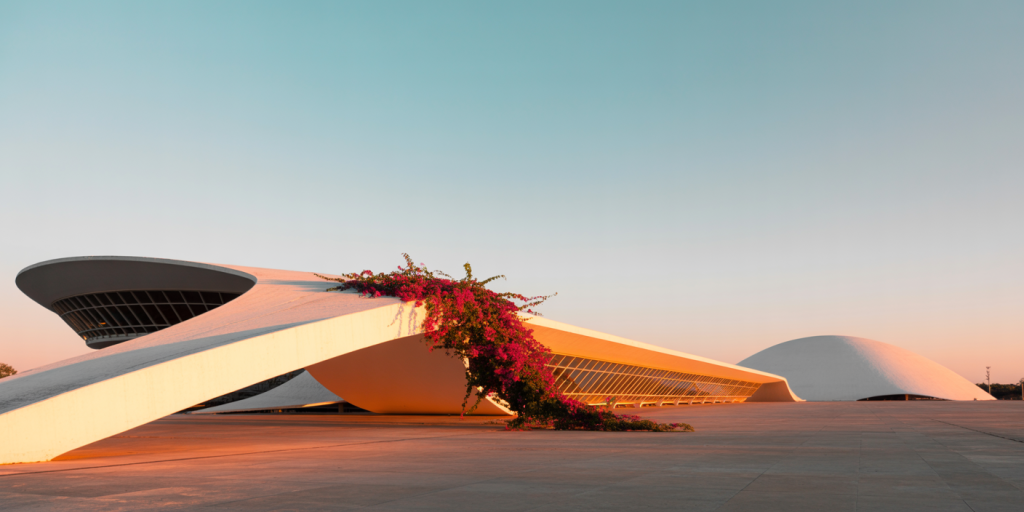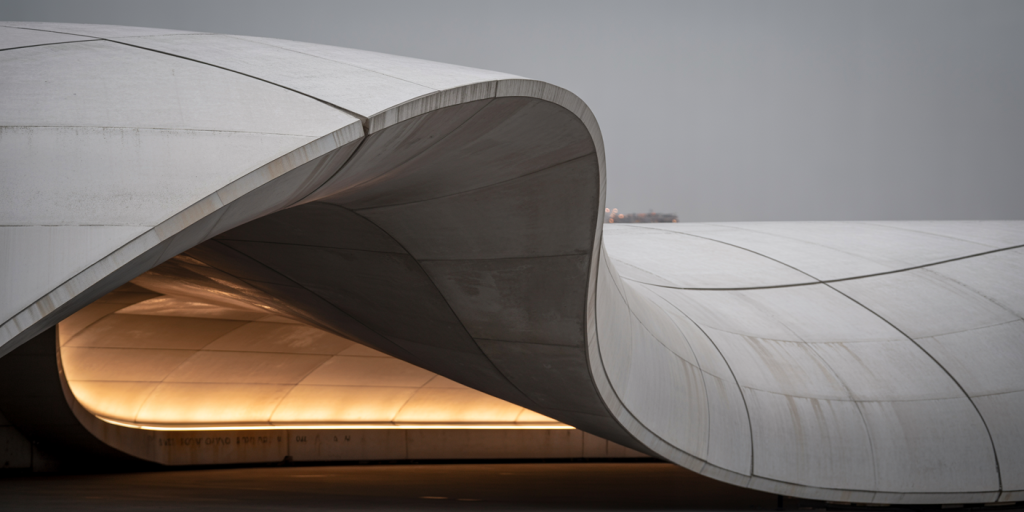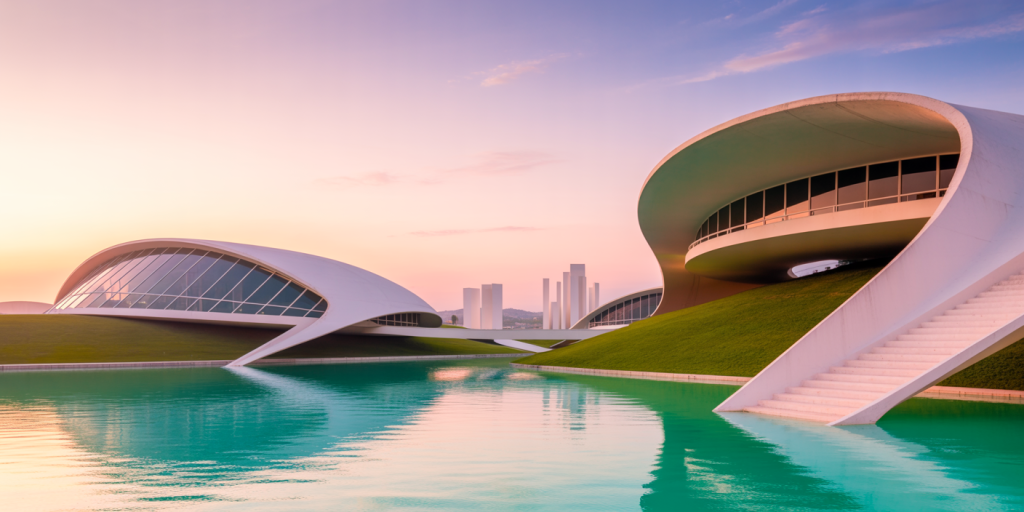Buildings Dream of Skies – By Oscar Niemeyer
Contemplative Opening
Some buildings do not merely stand—they float. They do not reach upward to dominate the sky but to converse with it. In Oscar Niemeyer’s world, concrete moves like wind, and structures do not serve—they seduce. His architecture is not anchored by gravity, but released by grace. His lines do not rise—they soar, in a slow ballet of material and imagination.
To walk inside one of Niemeyer’s buildings is not to pass through geometry, but through a dream. The curve becomes lullaby. The horizon becomes an eyelid half-closed in thought. And within the embrace of concrete, we do not feel enclosed—we feel liberated. Space breathes. And breath becomes memory.
Table of Contents
- The Curve as a Whisper
- Horizons That Bend Like Time
- Concrete That Breathes
- Niemeyer’s Geometry of Emotion
- Light Caressing Shadow
- Silence in White
- A Sky Built Slowly
- Structures Like Sentences
- The Body in the Line
- Sacredness Without Walls
- Brasília’s Poetry in Blueprint
- Space Suspended in Time
- Organic Modernism
- Color That Barely Speaks
- Feminine Forms in Steel
- Movement in Stillness
- Voids as Vessels
- Architecture as Slow Thought
- Monumentality Without Noise
- Final Gestures Toward the Sky
The Curve as a Whisper
Niemeyer once said that the straight line belongs to men, but the curve is God’s domain. In his architecture, the curve is a whisper—an intimate murmur between the earth and sky. It softens the modernist impulse. It refuses rigidity.
A building that curves is one that listens. It bends toward you, as if offering a hand, not a command. His curves hold emotion the way a poem holds breath.
Horizons That Bend Like Time
In Niemeyer’s work, the horizon is not a boundary—it’s an invitation. His low horizontal structures do not interrupt the landscape; they echo it. They become part of the land’s respiration.
These horizons do not divide—they join. Like a sentence stretched over silence. Like time folding gently into space.
Concrete That Breathes
Concrete, in Niemeyer’s hands, does not harden—it exhales. It loses its usual heaviness. It bends like silk, flows like a thought. The tactile quality of his buildings is one of softness, despite the material’s density.
This paradox—of weight made light—is Niemeyer’s alchemy. His architecture breathes because he molds material as if it were melody.

Niemeyer’s Geometry of Emotion
For Niemeyer, geometry is not cold—it’s tender. His forms are not dictated by rulers but by rhythms. The ellipse, the parabola, the wave—all serve an emotional logic, not a utilitarian one.
These forms do not measure—they feel. They hold space the way hands hold water: gently, protectively, reverently.
Light Caressing Shadow
Light in Niemeyer’s buildings is not a flood—it is a caress. It does not dominate; it dances. Through narrow slits, beneath swooping ceilings, light spills like secrets on stone.
This interplay with shadow creates movement. Even still walls shimmer with life, because light, like silence, speaks where words cannot.
Silence in White
White in Niemeyer’s palette is not absence—it is echo. His whiteness reflects more than color—it reflects sky, time, thought. White becomes a space of projection, where the viewer’s emotions are painted.
And silence is its companion. In his buildings, silence isn’t emptiness. It’s eloquence. A dialogue between structure and soul.
A Sky Built Slowly
Niemeyer builds skies. Domes, vaults, and arcs that seem not to hold up the roof, but to release it. His architecture does not press down—it rises, even in repose.
This slowness—this resistance to urgency—is part of the dream. It teaches us that beauty is not in speed, but in stillness earned through grace.
Structures Like Sentences
His buildings feel like language. Each element a syllable. Each void, a comma. A curve becomes a clause, a corridor becomes a pause. The entire form unfolds like prose that has no punctuation but feeling.
To walk through one is to read a poem aloud—with your feet.
The Body in the Line
There is something unmistakably bodily in Niemeyer’s lines. A hip, a breast, a reclining spine. His architecture is corporeal. Not anatomical, but sensual. The body becomes blueprint—not as machine, but as mystery.
The space doesn’t imitate the body—it welcomes it. It curves around you, embracing rather than enclosing.

Sacredness Without Walls
Niemeyer often designed churches and cathedrals—but never with conventional sanctity. His sacred spaces don’t preach. They breathe. Light filters in not through stained glass, but through open arms of structure.
Even in concrete, his chapels feel like prayers. Not shouted, but whispered. Not vertical, but expansive.
Brasília’s Poetry in Blueprint
Brasília was not just a city. It was a stanza drawn on the dry skin of a plateau. Niemeyer’s collaboration with Lúcio Costa turned bureaucratic order into poetic geography.
Its monuments don’t rise—they unfold. Its symmetry is not militaristic, but meditative. Brasília is the dream of modernism allowed to sleep under stars.
Space Suspended in Time
In Niemeyer’s buildings, time seems to pause. Not frozen, but suspended—like a droplet about to fall. You walk slowly not by instruction, but by invitation.
These are spaces that resist haste. That ask you to stay, to feel, to echo. The architecture does not contain time—it softens it.
Organic Modernism
He was a modernist—but not rigid. His modernism was tropical, sensuous, wet with emotion. He took the rational tools of the movement and infused them with music.
Steel and glass became instruments of poetry. And concrete flowed like water over stones.
Color That Barely Speaks
Color, for Niemeyer, is restraint. It comes in soft echoes—ochre tiles, red carpets, blue shadows. When color appears, it murmurs. It lets the form remain the voice.
Even his most colorful works are gentle. They do not scream for attention—they lean toward nuance.
Feminine Forms in Steel
Much has been written about the femininity of Niemeyer’s architecture. But it is not decorative femininity—it is essence. A form that yields, curves, breathes. That shelters without imprisoning.
These forms are strong, not fragile. They remind us that grace and strength are not opposites—but lovers.
Movement in Stillness
Though solid, his buildings seem to move. They ripple. They rise in slow waves. They arc like a dancer’s arm at rest. Stillness becomes choreography.
It is not literal movement—it is remembered movement. You look at his museum in Niterói and feel the echo of flight.

Voids as Vessels
What Niemeyer omits is as important as what he includes. His voids are not gaps—they are vessels. Places for light to land, for thought to hover, for breath to gather.
These empty spaces do not diminish the structure—they give it rhythm. As rests give music depth.
Architecture as Slow Thought
Each of his works feels like a meditation. Not on function, but on beauty. On the human condition. On what it means to live inside a line that cares more about wonder than profit.
His architecture slows the mind. It whispers to our better senses. It thinks, not in diagrams, but in lullabies.
Monumentality Without Noise
Niemeyer’s buildings are monumental—but never loud. They assert nothing. They invite everything. Their power lies in softness. Their scale is not imposition, but embrace.
This quiet monumentality redefines what it means to build. To be big without being arrogant. To be lasting without being loud.
Final Gestures Toward the Sky
Every line Niemeyer drew tilted toward the sky—not to reach it, but to honor it. His architecture is an offering. A gesture. A curve extended like a hand.
And the sky, in turn, receives these gestures with clouds, with shadow, with breeze. A dialogue between gravity and grace.
FAQ – Frequently Asked Questions
Who was Oscar Niemeyer?
A Brazilian architect and key figure in modern architecture, known for designing Brasília and for his use of curves, light, and poetic minimalism.
What defines Niemeyer’s style?
The use of fluid, curving forms; integration of space and emotion; and an architectural language that blends modernism with sensuality and poetic imagination.
Was Niemeyer influenced by other architects?
Yes, notably Le Corbusier, but he departed from strict rationalism to embrace a more fluid, organic approach rooted in Brazilian culture and landscape.
How did Niemeyer use concrete differently?
He treated concrete not as a rigid industrial material but as a malleable, expressive medium capable of fluidity and grace.
What is the significance of Brasília?
Brasília, designed with Lúcio Costa, was a political and artistic statement—a city built from scratch, symbolizing Brazil’s future and embodying modernist ideals through Niemeyer’s architecture.
Final Reflections – Curves That Continue in Us
Oscar Niemeyer did not simply construct buildings—he composed dreams. His curves do not end at the edge of the structure; they continue in the viewer’s breath, in the thoughts they shape, in the sky they reflect.
To stand before his work is to soften. To be reminded that architecture, at its most human, is not about enclosure—but about invitation. A place not to hide from the world, but to dream with it.
